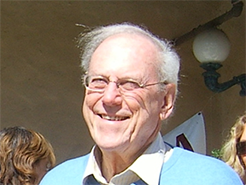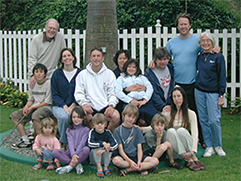A Statistician’s Life: Bob Riffenburgh
Kim Gilliam, ASA Marketing and Communications Coordinator

After the ASA San Diego Chapter became official, Riffenburgh served as liaison to the ASA for several years. He was named an ASA Fellow in 2000.
For more than 65 years, Bob Riffenburgh practiced and taught statistics in multiple fields—fisheries, oceanography, education, psychology, sociology, economics, agriculture, space exploration, business, military simulations, and, for the last three decades of his career, medicine. Today, retirement has allowed him to pursue a childhood passion—fiction writing.
Riffenburgh grew up in depression-era Appalachia in Blacksburg, Virginia, on the Virginia Polytechnic Institute campus, where his father was a chemistry professor. “I was raised in the world of scientific inquiry,” he says. “Our house sat next to a crop field used for agricultural experiments. And I remember vividly time spent with my dad in his research lab.”

Riffenburgh as a youngster. He grew up in Blacksburg, Virginia, on the campus of Virginia Polytechnic Institute, where his father was a chemistry professor.
“Education was important in my family,” says Riffenburgh. My parents listened and took me seriously, so I grew up feeling confident in my abilities,” says Riffenburgh. “However, social relationships were another matter—they were not scientific.” He confides, “I didn’t do so well in that realm.”
In high school, he enjoyed every subject—math, science, history, literature—and had an insatiable curiosity about everything. He was lead in the senior play, was on the tennis team, and played saxophone.
In his youth, he also had a head for numbers. He says, “I counted everything from childhood, tallying data, tabulating distributions, and making decisions on subjective probability estimates. I had no idea that I was edging on statistics.”
The Making of a Statistician
Riffenburgh’s father passed during his last year of high school, and he was sent to Colorado to live with an uncle. In 1948, he enrolled at Colorado University on a state scholarship. He says he received bad academic counseling advice from a volunteer faculty adviser, who placed him in algebra 3 before algebra 2 and suddenly the “A” student failed his first course. He lost his scholarship, became terrified of anything mathematical, and gravitated toward psychology as a major.

Bob Riffenburgh with his family. He has five children with his wife, Gerrye.
Riffenburgh returned to Virginia to attend the College of William & Mary. He put himself through school on a shoestring budget, eventually earning an MS in industrial psychology. “In time, however, I became disenchanted with the poor science that permeated psychology then,” he says. “VPI had started one of the earliest statistics departments and, in my hometown, they would accept me despite my unpreparedness in math. I realized why I had failed the math course at CU, and that I could be successful if I applied myself.” He did and earned a PhD in statistics with a minor in mathematics in 1957.
From Academia to Undersea Diving to NATO Officer
Riffenburgh taught elementary mathematics as an assistant professor at Virginia Polytechnic Institute during his last two years of doctoral study. He then accepted the same rank at the University of Hawaii, which he says, “sounded so romantic with the promise of adventure.” By then, he was married to a former classmate, Gerrye Harlow, with their first two children (of five) in tow. He worked a side job for the US Bureau of Commercial Fisheries to buy a house and sloop and became an “ocean sailor.”
However, the isolation of the Hawaiian Islands became an issue and prompted a return to the mainland. In Monterey, California, he did a stint outside academia as a systems analyst at the Lab for Electronics, estimating probabilities of collision between rockets and satellites.
But then he received an offer he could not refuse—a full professorship and the opportunity to establish a statistics department at the University of Connecticut. He planned course offerings, hired faculty, recruited students, developed a graduate program to offer MS and PhD degrees, taught classes, published papers, and performed other duties required of a department head.
He also received requests from industries for advice on data analysis and decisions, so he formed a consulting firm, the General Systems Analysis Company, and ran it simultaneously for years. His clients included IBM, Olivetti, New York Life, and Emhart Manufacturing.
“After nearly a decade, I was getting burned out and returned to the West Coast for an oceanometrics position at the Naval Ocean Systems Center in San Diego. As part of my job, the Navy sent me through undersea diving school, and I dove to plant measuring gear and monitor undersea data. Eventually, the Navy sent us to Wales for three years to help found a surveillance system for Soviet ballistic missile submarines.
“Back in San Diego, I was sent to the Naval Hospital in Balboa Park for a couple of years to advise on the design and analysis of medical studies. Then, the Navy deployed me to Holland and then Italy for eight years, where I headed naval operations research as an officer in NATO. My team did military simulations and recommended the optimum mix of support to be provided by the respective NATO navies should the Soviets start World War III. The Soviet empire collapsed, and I returned to San Diego and retired from the government.”
After retiring, the naval hospital asked him to return as their biostatistician under contract, which he did for the next 28 years, designing and analyzing more than 3,000 studies across all fields of medicine. He wrote his biostatistics book, Statistics in Medicine, and shepherded it through four editions. In 2019, he left the hospital, returning to San Diego State University (where he had been teaching part-time) for a few more years; in 2021, he retired for good.
ASA and the Bob Riffenburgh Award
Riffenburgh joined the American Statistical Association in 1955 as a graduate student. He was active in local chapters, serving as an officer and giving lectures in the Hawaii Chapter, Connecticut Chapter, and San Diego Section of the Southern California Chapter. He served as chair of the local affairs committee for JSM in 1979, arranging everything locally. “This took most of my time for months,” says Riffenburgh. After the San Diego Chapter became official, he served as liaison to the ASA for several years. He was named an ASA Fellow in 2000 and is a PStat.
This year, the Riffenburgh Award was established in his honor. It recognizes the transfer or extension of statistical methods developed for or used in one field of application into another where it has never or seldom been used. Its goal is to recognize that these statistical transfers broaden the range of statistical methods applied to various science fields and encourage statistics users to seek innovative methods not commonly used in their field.
Riffenburgh says some of his most satisfying contributions to statistics were introducing previously unused statistical methods to applied fields. Some examples include the following:
- A Markov-chain system analysis (Proceed Internat Statist Inst 1960) and system modeling of fish schooling (J du Conseil 1960) to marine biology
- Multiple discriminant analysis (Sociometry 1966) to sociology
- AI-controlled robotic data devices (Cybernetica 1966) to space exploration
- Analysis of variance (Deep-Sea Research 1970) and change point detection in time series (Technometrics 1971) to physical oceanography
- Greatest extreme stress prediction (US Bureau of Reclamation Reports 1973 and IEEE Proceedings 1976) to engineering construction
Then there were several transfers from one medical field to another, starting with statistical logic (Archiv Otolaryngol 1996) and detecting survival patterns in disease progression (Cancer 2001) and continuing to bias correction in medical markers (Amer J Med Sciences 2022).
The award is to be funded through the endowment created by a gift bestowed upon the ASA by Riffenburgh. The first award will be presented at the Joint Statistical Meetings in 2023.
Hopes for the Future of Statistics and Data Science
“Statistics and data science overlap about 90 percent. Their role is clear,” says Riffenburgh. “The combined discipline forms two bridges. One is a pre-data bridge from having a concept to developing a scientific design. The other is a post-data bridge from holding raw data in your hand to developing an understanding of what the data mean. No one knows about the future, but one certainty is that the need for currently unimagined statistical methods will arise.
To illustrate, let’s go back 65 years and ask the statisticians of that day what statistics would be like now,” says Riffenburgh.
“I think one anecdote illustrates the essence. With hand calculation of statistical methods, sample sizes were necessarily small. The problem always seemed to be how to get enough data to satisfy assumptions. In 1957, when I was finishing my doctorate, one of my professors, John Freund, was called to consult with an aircraft construction company. Aircraft were becoming jet-powered, and speeds were increasing, generating wing flutter.
The day Dr. Freund arrived back, we were all sitting around a calculation room eating our brown-bag lunches. His eyes were as big as salad plates. He said, ‘You won’t believe this. They have data as I have never seen—wing flutter data recorded by the thousands. It’s not a problem of how to get data; it’s a problem of how to choose what subsets of data to use for analysis.’ That evolved into the current demand for new forms of statistical thinking demanded by vast data sets such as those in genomics.”
Advice for Tomorrow’s Statisticians and Data Scientists
Riffenburgh suggests burgeoning statisticians and data scientists develop a feel for statistical methods rather than just follow formulas. “Formulas are like road maps,” he says. “You need them to navigate, but they are not the trip. The trip is in the mind and emotions. You need a gut feeling for a method, not a stiff protocol. A statistical problem lies in a process. Data shine a light on the process. Often, there are different windows to look through at a problem and, while one might be more efficient than another, they may all show you insights into the process.”
He adds, “The whole point of statistics is understanding how the process works, not producing some optimal-but-dry statistic. This is what the younger generation should keep in mind. Don’t think of statistics as a pairing between a static problem and a static method. Think of finding the picture the data tell you.”
Looking Back and Moving Forward
Riffenburgh’s 65-year career took him around the world applying statistics to myriad disciplines. He was asked how he managed it all. “The activities kept me so busy that I never had time to think about what to do next. Everything just seemed to happen—marriage, children, jobs, moving about, fitting in, learning new stuff. I just did whatever I had to do. I felt like I was just surviving the buffeting waves of life.”
At 91, Riffenburgh has had to give up some of the joys of his younger days—sailing, ocean diving, running, and building things. Today, he enjoys listening to and making music. He loves cooking and has fun creating unique dishes. And he finally has the time to devote to a creative passion: writing fiction—novels and short stories.
“In the past, nonfiction writing taught me discipline, patience, organization, clear and simple expression, and the ways of publishers—all required in a well-written novel. A hallmark of my writing is believability—feasible events peopled by credible characters set in technical authenticity. For me, writing novels adds the thrill of creating people and events in the world of the mind,” says Riffenburgh.

















